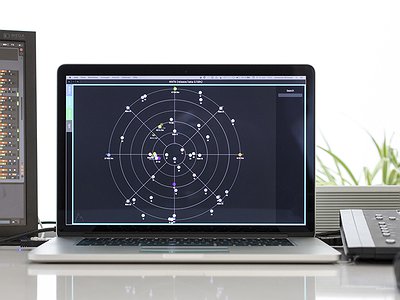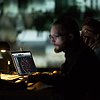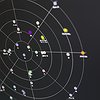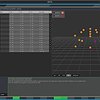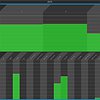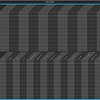There are endless possibilities with MNTN, but I would assume that not all will be equally successful. What makes a certain sound constellation truly 'immersive' would you say? What are configurations that come closest to achieving your dreams when you began working on MNTN?
You really have to unlearn everything that you know from producing in stereo and treat this as a new language, which it truly is. What I learned from my project is how silence is a very important ingredient in composing spatially. If you flood the space with a lot of sounds, even though you sense the direction of each sound object, the effect isn't as strong as something appearing and disappearing in relation to silence. Hence, percussive elements are very potent. You also really have to know what you are going for, what experience you want the listener to have. Because it's not just about what the sound conveys, like with music, but also about your perception of a spatial architecture, which could even emulate real spaces, real architecture if you want it to. Coming from a music which was heavily informed by Dub, I can already hear a new definition of Dub being born in this format, one that will give more spatial possibilities, yet will also require more restraint as well. You really need to make sure that you also include the negative space for the effects to work against. Personally, for me, the dream is a vanishing point that never arrives. Of course, there are things that I hear in my head that I will be pursuing with sound, but it will be just as gratifying to listen to what others do with this format when they put their hands on it. The sky's the limit and each true artist is a planet. What we really need now is an intense creative dialogue.
You've stated that you would ideally like to create a program that allows its users to play immersive sound like an instrument. In which way is this possible with MNTN?
MNTN lets you move sound objects through space, you can think of it (the software) as a tool that allows you to do that, and the space through which these sound objects move as the canvas. By itself it's just a tool and the space is a space to project your ideas on. It's nothing without the user or the artist. And, from seeing what happened with Ableton, I’m pretty sure that no two artists will use it the same way or for the same exact purpose. Like with any instrument or tool, the magic happens when you have a skillful person using it. And with art, the ideas and your emotional depth are absolutely essential, because those are the real ingredients. Like I said before, this format was for a long time limited only to the cinema world (mostly high budget projects) and video gaming, which is also a costly sport. I hope that more musicians and sound designers will be able to jam with this format, experiment with it, try things out just for the fuck of it. And that artists will use it to express what they hear, feel, think and that it will give them access to possibilities that weren’t available previously. We definitely need some John Coltranes of 3D sound up in here!
Does the software also change the sound of the music in the stereo image? If so, in which way?
MNTN only affects the position, not the sound of an instrument. The only colour that’s added is through the binaural rendering. That’s the nature of binaural rendering. It basically simulates the coloration caused by the outer ear, the shape of your head and your shoulders, just like what happens with natural spatial hearing. The colour also changes gradually depending on where you move a sound in a space, or in which direction you turn your head. You can test this in real life. If you push your ears out with your hands, the sound changes drastically because you're not used to the reflections added by your hands.
Do you see applications for MNTN outside of sound art, maybe in fields like live recordings of music like jazz, rock, and classical or new hybrid genres?
Absolutely. I think cross-pollinating any of these genres with the ability to manage space offers new approaches to them. At the least, you can use MNTN to enhance your stereo picture and to create more space in the mix. It's great for drums and if you want to create depth in your string arrangements. I think that there is a lot of room in film sound design at the indie level, for sound designers to be able to step up their game. To date, indie film budgets have put considerable constraints on what was possible with sound. Classical music, or lets call it neo-contemporary, like any progressive form of music, is also about finding new sonic solutions. I’m sure that this format will find some interesting applications there. For composers who score movies, now they can work with spatial design at a compositional level, and they can interject elements of pure sound design into the music itself. I also think that some of the things which will be fully fleshed out in truly experimental circles, might, in their diluted version, eventually make it into the mainstream. I mean, look at how drum mixing changed post Hip Hop or the use of space and vocal treatment post Dub and then after the -+first wave of Dub Step. This sonic vocabulary has been absorbed by the mainstream full on, but it started with a handful of people just reaching for something that they heard in their heads – often breaking the established rules of music making.
It is remarkable, in a way, that we have arrived in the 21st century with the basic concept of music still intact. Do you have a vision of music, an idea of what music could be beyond its current form?
It depends on how we change as humans at a biological level. Music is still the way it is because we haven't changed much as a species, relatively speaking. We still interact with the world using our senses and we are still rooted in this sensorial experience of this physical world. Out of this experience we create systems of communication that make sense of this very experience and that mimic it and explain it or alter it, to some extent. I think that you could draw a line from some proto-humans being fascinated by bird sounds, to our appreciation for a melody. Banging on two sticks, or hearing a herd galloping across some pasture, or hearing a heartbeat – to our love for rhythm. When you listen to classical music you can hear nature in it. When the industrial age arrived the sounds of the machines started to bleed over into song aesthetics. Now, a lot of music sounds like the digital technology that surrounds us on daily basis. As long as we will inhabit these type of bodies music will always be rooted in our relationship with the physical world. We will always negotiate between the idea of noise and music. Certain sounds will trigger certain things in us: whether pleasant or repulsive. And aesthetics will adapt to these circumstances.
The interesting thing that we are faced with now is if we will continue to exist as this particular species and in this particular form. The technologies we are creating are starting to extend certain parts of us. Arguably, the first generation of man-machines is out there already with their mechanical prosthetics and digital amplifiers for physical senses or even full on replacements. And now, we're entering a stage in our society where VR will be accessible to the masses. Interfaces are being developed that will allow for the further blurring of the boundaries between our mind–bodies and technology. It's hard to say what effect this will have on us as individuals and as a society. Who will we become as a species in the next 50 to a hundred years? Will there be a need to tell stories in the future? Will we still have a need for beauty? Will we still be driven by our internal, biological chaos – our hormones and emotions? Will we still need art to help us make sense of it all? Will we even be here?

